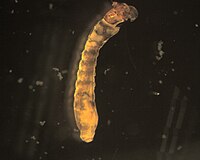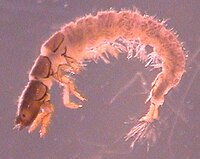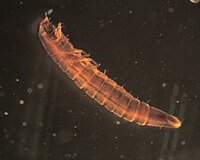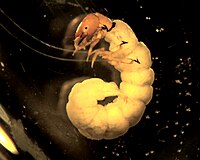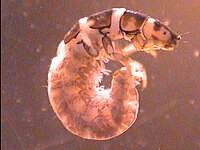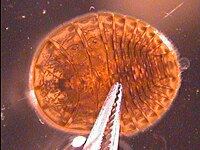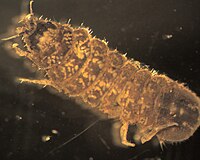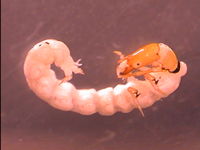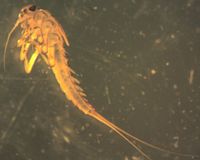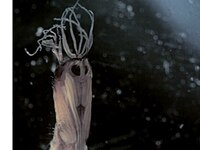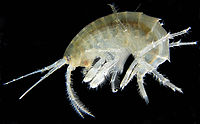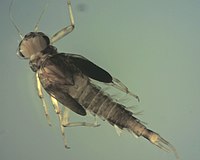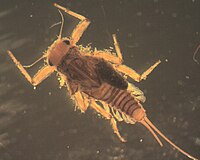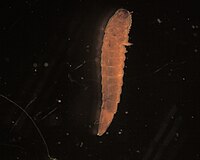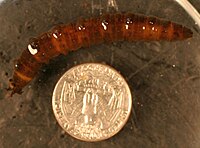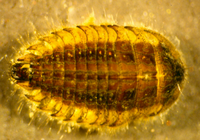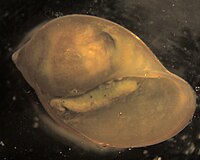Vermont EPSCoR's Streams Project; A Teacher Collaboration on WikiEducator
Openly shared content, practices, and developing resources from Vermont EPSCoR's Streams Project. Join this collaboration and make a difference!
 Indian Kill |
|---|
|
| Stream code: | HRD_IndKill_49 |
| Basin: | Hudson River |
| State or Province: | New York |
| Country: | USA |
| Latitude: | 41.840505 |
| Longitude: | -73.933632 |
| School: | Poughkeepsie High School |
The following are the most common invertebrates collected from this stream site.
Chironomidae
- Order
- Diptera
- Family
- Chironomidae
- Common name
- Nonbiting midge
- Tied fly
- Griffith's Gnat
Midge larvae tend to be the most common macroinvertebrate at our sites. As with other Diptera, there are no true jointed legs. Chironomidae do have a pair of prolegs at each end and preserved individuals tend to curl into a 'C'. Identification past family requires slide-mounted heads. We have seen philopotamid caddisflies misidentified with the chironomids and we suspect that that happens when samples are being sorted from trays. Under a microscope, six prominent legs can be seen on members of the caddisfly family Philopotamidae.
More information on Philopotamidae.
Simuliidae
- Order
- Diptera
- Family
- Simuliidae
Simuliidae appear rather like bowling pins with heads. Relatively speaking, we collect few members of this family and have we have not identified them past family at this point.
Click here for a close up image of the heads.
Cheumatopsyche
- Order
- Trichoptera
- Family
- Hydropsychidae
- Genus
- Cheumatopsyche
Cheumatopsyche has a
forked foretrochantin (as does
Ceratopsyche). The foretrochantin is the projection at the uppermost portion of the front leg closest to the head. The leg may need to be pulled away from the body to expose this feature.
Cheumatopsyche have a small or inconspicuous
pair of sclerites under the prosternal plate that are difficult to see. Contrast that with the
larger pair of sclerites found on Ceratopsyche. To access sclerites, it's best to gently pull the pronotum and mesonotum in opposite directions. Note: the large single sclerite is the prosternal plate.
Cheumatopsyche have only 2 types of
hair on the abdomen: long thin plain hairs and thicker club hairs, which are narrow close to the body and widen out at the distal end. Paired sclerites on the ninth abdominal segment are notched.
Stenelmis
- Order
- Coleoptera
- Family
- Elmidae
- Genus
- Stenelmis
The larvae of
Stenelmis, as in
Ordobrevia, have a sternum on the ventral side of the pronotum. The main difference between the two genera is in the antennae the second segment is less than twice as long as the first in
Stenelmis.
The adult Stenelmis has a clear separation between the thorax and abdomen as well as a more distinctly separate head as compared to other genera.
Click here to see pictures of the sternum and
antennae-
Dolophilodes
- Order
- Trichoptera
- Family
- Philopotamidae
- Genus
- Dolophilodes
Ceratopsyche
- Order
- Trichoptera
- Family
- Hydropsychidae
- Genus
- Ceratopsyche
Ceratopsyche has a
forked foretrochantin. The foretrochantin is the projection at the uppermost portion of the foreleg. The leg may need to be pulled away from the body to expose this feature.
Ceratopsyche have a
large pair of sclerites underneath the prosternum. Note: the large single sclerite is the prosternal plate. Biologists have gone back and forth between lumping this genus into
Hydropsyche and splitting it back out. ITIS currently lists it as a genus (Feb 2013) but we are aware of a recent paper that lumped it under
Hydropsyche.
Psephenus
- Order
- Coleoptera
- Family
- Psephenidae
- Genus
- Psephenus
The true "water penny" is commonly found in the waters sampled.
Psephenus has a rounded shape with relatively smooth edge. The
false water penny, whose edges are serrated, has a more oval appearance. The
gills on the ventral surface are found only in the true water pennies.
Another genus encountered in this family is Ectopria.
Asellidae
- Order
- Isopoda
- Family
- Asellidae
- Common name
- sow bugs
These aquatic sow-bugs have seven pairs of legs and a dorso-ventrally flattened body. They have two pairs of antennae; one pair is much longer than the other pair.
Images of the body and the two pairs of antennae.
Chimarra
- Order
- Trichoptera
- Family
- Philopotamidae
- Genus
- Chimarra
Chimarra are distinguished from the other Philopotamidae by a prominent asymmetrical notch in the frontoclypeus as well as a prominent process on the femur which bears a single hair (seta).
Images of the asymmetrical notch and prominent process.
Hydropsyche
- Order
- Trichoptera
- Family
- Hydropsychidae
- Genus
- Hydropsyche
- Common name
- spotted caddis
- Tied fly
- dark cahill
Hydropsyche are net-spinning caddisflies and share most characteristics with other members of the Hydropsychidae, including the
Ceratopsyche.
Hydropsyche are distinguished from
Ceratopsyche by the presence of scale hairs and minute spines on the three most posterior abdominal segments.
More information on the Ceratopsyche can be found here.
Image of the sclerites in the intersegmental folds.
Pisidiidae
- Order
- Veneroida
- Family
- Pisidiidae
Fingernail clams are the most common small clams that we find in Vermont rivers. Larger bivalves should not be sampled because they may belong to a protected species. Under no circumstances should clams be moved from one river site to another.
Baetis
- Order
- Ephemeroptera
- Family
- Baetidae
- Genus
- Baetis
- Common name
- The Little Olive
- Tied fly
- Sawyer Pheasant Tail Nymph
This mayfly has three "tails" and a unique head shape. Its gills are oval shaped and insert dorsally. More mature nymphs have long, dark wing pads.
Image of the long, dark wing pads.
Diptera
- Order
- Diptera
- Tied fly
- Griffith's Gnat
Pupae from the order Diptera are typically found in small numbers at every site. These can be identified further, but we do not.
Gammaridae
- Order
- Amphipoda
- Family
- Gammaridae
The body of this scud is flattened side-to-side. It has seven pairs of walking legs and two pairs of antennae. On third third antennal segment, there is a segmented flagellum.
Images of the body flattened side-to-side, and the segmented flagellum.
Acerpenna
- Order
- Ephemeroptera
- Family
- Baetidae
- Genus
- Acerpenna
- Common name
- Tiny blue-winged olive
This genus is can be identified by the costal process, or projection, distal to the hind wing pad. Gill 7 is slender and may be pointed at the end. The antennal scape and pedicel have a few scattered setae (hairs).
Image of the antennal scape. A ventral view can be seen here.
Siphlonuridae
- Order
- Ephemeroptera
- Family
- Siphlonuridae
- Genus
- Siphlonurus
- Common name
- The Gray Drake
- Tied fly
- Gold-ribbed Hare's Ear
This family has gills on all abdominal segments. The labrum does not have a deep notch, and maxillae do not have pectinate spines. They have posterolateral spines on their last abdominal segment.
Click to view the spines on the last abdominal segment, unlike those found in Baetidae.
Optioservus
- Order
- Coleoptera
- Family
- Elmidae
- Genus
- Optioservus
The larvae of
Optioservus have open coxae, as determined by the straight definition between segments on the ventral side of the pronotum.
The adult Optioservus have a compact appearance, especially the head and thorax. There are also dorsal ridges and a characteristic diamond-shaped sutellum observable in the dorsal view.
Images of the straight definition between segments, the dorsal ridgesand the diamond-shaped scutellum.
Nigronia
- Order
- Megaloptera
- Family
- Corydalidae
- Genus
- Nigronia
Members of the genus
Nigronia share some superficial commonalities with Trichoptera, but on careful inspection one can see the two pair of anal claws that help place it in the order Megaloptera. The size of mature larvae is impressive; specimens from other genera exceed 8 cm in length. The abdominal segments have ribbon-like gills on the lateral portions. The mouth has mandibles that are serrated and used for biting prey. They can be confused with the more slender whirling beetle larvae; whirligig larvae also have simpler jaws.
Images of the two pairs of anal claws, whirligig beetle larvae and their simpler jaws.
Tipula
- Order
- Diptera
- Family
- Tipulidae
- Genus
- Tipula
This genus of Tipula is rather large as compared with other genera. Tipula larvae are generally dark brown and have creeping welts.
Ectopria
- Order
- Coleoptera
- Family
- Psephenidae
- Genus
- Ectopria
False water pennies are less circular than true water pennies, and come to a blunt point at the back end. They appear to have serrated edges and lack gills.
Another genus encountered in this family is Psephenus.
Physidae
Members of the family Physidae belong in the class of Gastropoda. Members contain a single, coiled shell with a left handed spiral going counterclockwise. Belonging to the family of aquatic pulmonates, members breathe air using a structure similar to a lung.
Images of the family Physidae, the class of Gastropodaand a shell with a left-handed spiral.


